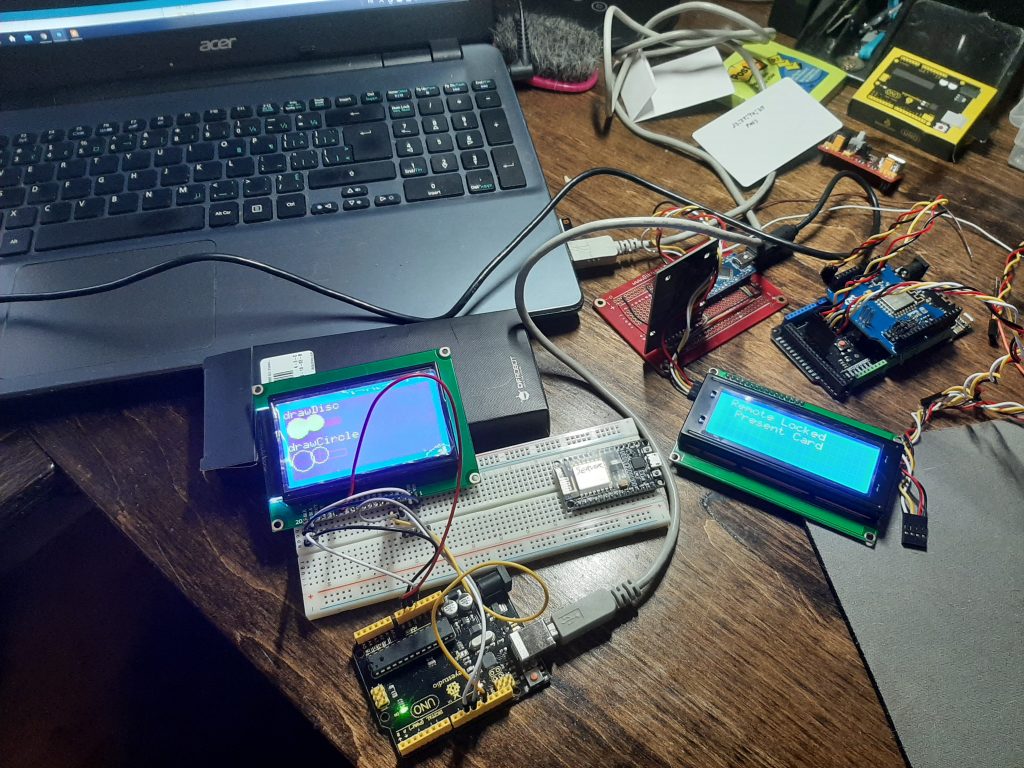Yeah, not much to post this week, and here’s why:
I’ve been spending the whole week designing, testing and building stuff for Lady Arsenique to make a remote-controlled / automated bondage cell, with RFID access and other wonderful stuff, all based on Arduino (Uno, Nano, Mega, ESP8266 for those who are into this stuff).

Lots of thinking, trial, errors, a few involuntary smoke tests (Thanks my dyslexia for inverting the power wires). I haven’t played with Arduino for over a year, and I’m fucking rusty… Hell, that blue GLCD on the left, I’ve had that thing for 10 years! Never used it. Plus I’m going with new stuff, like the ESP8266. Imagine a slave, stuck inside that room, a tens unit carefully positioned which could be triggered at will through a web interface.
So, the mind is not really into writing / imagining any fetish stories, although the ‘thoughts’ are there.
Spamming:
On a different note, I’ve been hit with heavy spams for the last week or so, getting about 15 messages a day that I have to trash. I’ve installed a spam filter. If anyone of the REAL YOU is having any problem posting a comment, please don’t hesitate to write directly to me.
Pierre.

Arduino is a name I haven’t heard in a long time. This is very interesting to me.
What are the benefits of an Arduino with a display panel compared to a cheap ARM device like an old smartphone?
Hi Jarl.
I’m not sure how to answer that, but for one, I would say that the Arduino is a heck of a lot easier to program than taking apart an old smartphone and try to hack into it, to get acces to output pins and stuff.
Arduino comes with a lot of libraries, so you don’t have to work to create one. Plus the built-in I2C, IIC and serial interfaces. And finally, I already know Arduino, so…
How do you connect to the Tens unit? Are there ones out there that have a suitable serial console or pins suitable for controlling the signal amplifier with the microcontroller?
Hi Mlio.
I’m assuming you have some technical knowledge, so I’ll plunge right to it.
The output GPIO voltage of a ESP-8266 is 3.3Vdc at 12mA. You need to go through a transistor to power anything from those. The tens unit I have is powered by a 9V battery and uses about 40mA. The ESP needs a power source between 5 and 10vdc (it has an integrated regulator that drops it down to 3.3v for its use). I power the ESP with the battery, link the output to a transistor 2N2222, and complete the power-up circuit for the tens unit through the 9V battery and the transistor.
I did popped open the tens unit to get access to the battery wires. I should (received what I needed just half an hour ago) put the ESP inside the tens unit in the battery compartment, in place of the battery. I will add one (or two) external 9V battery holders to hold the “power source”. The thing is that the ESP draws 70mA. The tens 40mA. So, I’m at 110mA. A 9V battery has a 550mA/H capacity, which means that, at that power consuption, it might last one to 2 hours before its voltage is to low to operate anything (assuming the tens is powered up continually). Putting two in parallel should double that power time window.
The tens unit I’m using for this project is similar to this one:
https://www.amazon.ca/Tens-3000-Professional-TENS-Relief/dp/B01CB8PJ18/ref=pd_sbs_7?pd_rd_w=uiXVS&pf_rd_p=ba284f11-925a-4926-8142-0043fa482b41&pf_rd_r=1TBAMEZ669YBW3E0WBMH&pd_rd_r=ad73c1d8-9b69-4450-ab12-d9b728319c97&pd_rd_wg=OpYnb&pd_rd_i=B01CB8PJ18&psc=1
Pierre.